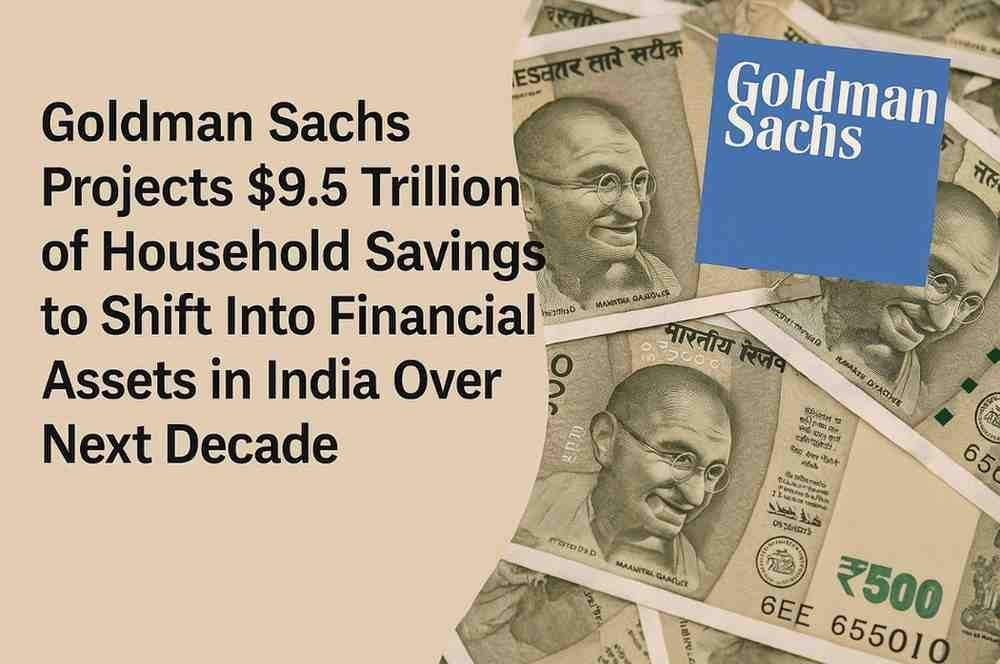India’s household savings are poised for a transformational shift. According to a recent report by Goldman Sachs, household financial savings in India are expected to generate approximately USD 9.5 trillion in inflows into financial assets over the next ten years. This projection marks a notable uptick from the previous decade and signals a shift away from traditional physical assets toward more modern, financial investments.
1. Projected Savings as a Percent of GDP
Goldman Sachs anticipates that household financial savings will average around 13% of GDP over the coming decade, compared to an average of 11.6% over the past ten years. This increase in savings share underscores growing consumer confidence in financial instruments and a deeper penetration of financial services in Indian households.
2. Breakdown of Asset-Channelled Inflows
The report outlines the expected distribution of these massive inflows across various financial instruments:
- Long-term savings products (such as insurance, pensions, and retirement funds): anticipated to receive over USD 4 trillion.
- Bank deposits: expected to attract around USD 3.5 trillion.
- Equities and mutual funds: projected inflows in the range of USD 0.8 trillion.
This diversification of allocations highlights the growing confidence of Indian households in structured financial instruments beyond conventional options like real estate and gold.
3. Drivers of the Shift: Financialization of Savings
The phenomenon described by Goldman Sachs reflects a broader “financialization” trend, where households increasingly redirect savings into financial markets rather than traditional physical assets. As incomes rise and financial infrastructure deepens, this pattern mirrors trends seen in economies at similar stages of development.
Several factors underpin this shift:
- Greater access to financial products: Broader distribution channels, digital platforms, and financial literacy campaigns have made it easier for households to invest.
- Regulatory and institutional support: Pension reforms and retirement planning vehicles are gaining traction.
- Macro-economic confidence: Expectations of higher long-term returns, coupled with stable macro fundamentals, encourage financial asset accumulation.
4. Macro-Economic Implications
Goldman Sachs emphasizes three key implications of this expected increase in household financial savings:
a) Stable Funding for Corporate Investment
The inflows will provide a resilient funding base for corporate capital expenditure, reducing reliance on volatile external or institutional funding sources. This could catalyze infrastructure development, industrial expansion, and broader economic growth.
b) Support for Long-Duration Bond Markets
Significant allocations into long-term savings vehicles can bolster long-duration bond markets, helping to deepen fixed-income securities and enhance interest rate stability. This may also improve access to credit for long-term projects.
c) Expansion of Retail Participation in Capital Markets
With USD 0.8 trillion expected in equities and mutual funds, the report underlines a rapid democratization of capital market participation. An expanding retail investor base can enhance market liquidity and resilience, provided investor protection and guidance keep pace.
5. Broader Context: Comparing with Other Economies
Although Goldman Sachs doesn’t provide direct comparisons in the summary, the pattern resonates with trajectories observed in other fast-growing economies. Historically, rising middle-income populations gradually allocate more to financial assets as financial systems mature. India appears to be following this well-trodden path, but at a significantly accelerated pace.
6. Potential Challenges and Risks
While the projection paints a positive outlook, several challenges merit attention:
- Market Volatility: A surge in retail participation, especially into volatile instruments like equities, could introduce market instability if liquidity is not sufficient.
- Financial Literacy Gaps: Many investors may lack the sophistication to evaluate risks adequately, increasing the chance of poor outcomes.
- Regulatory Readiness: Oversight institutions, particularly for mutual funds and insurance, must scale up to manage the growth effectively.
- Banking Sector Capacity: Absorbing an additional USD 3.5 trillion in deposits may strain banking infrastructure if not supported by simultaneous credit deployment.
Addressing these challenges proactively will be critical to sustaining momentum and ensuring long-term investment health.
7. What This Means for India’s Future
Overall, Goldman Sachs’ projection suggests:
- A structural shift in household behavior toward financial markets.
- The emergence of a powerful domestic capital pool to fuel investment across sectors.
- A maturing Indian financial system that increasingly serves long-term development goals.
Investors, policymakers, and financial institutions should prepare for a landscape where household financial resources play an increasingly pivotal role.
8. Conclusion
Goldman Sachs’ forecast of USD 9.5 trillion in household financial asset inflows over the next decade is more than just a number—it represents a paradigm shift in the Indian economic story. With rising savings rates, diversified allocations, and growing retail investors, India is poised for deepened financial integration and capital-led growth. But success hinges on maintaining financial stability, enhancing investor education, and building resilient regulatory frameworks.
If you’d like, I can help summarize the report’s key charts, guide you through comparable studies from other emerging economies, or map out likely impacts across sectors like pension reform, asset management, or urban infrastructure financing.

